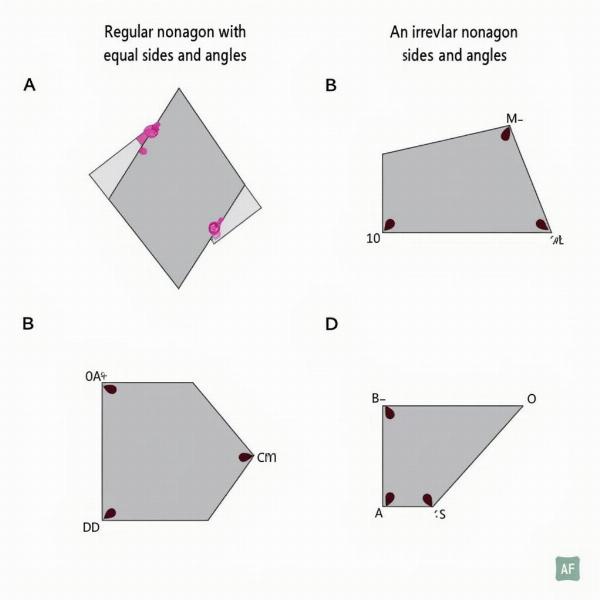Understanding the meaning of “nonagon” in Hindi opens up a world of geometric understanding. This article will delve into the various aspects of a nonagon, from its definition and properties to its significance in different contexts. We’ll explore how this nine-sided polygon translates into Hindi and its relevance in various fields.
Understanding the Term “Nonagon”
A nonagon is a polygon with nine sides and nine angles. The term originates from the Latin word “nonus,” meaning nine, and the Greek word “gonia,” meaning angle. In Hindi, a nonagon is called “नवभुज” (navabhuj). “नव” (nava) stands for nine, and “भुज” (bhuj) translates to sides or arms. So, quite literally, “navabhuj” describes a figure with nine sides.
Different Types of Nonagons
Just like other polygons, nonagons can be categorized into regular and irregular nonagons. A regular nonagon has all sides and angles equal, while an irregular nonagon has sides and angles of varying lengths and measures. Another classification divides nonagons into convex and concave. In a convex nonagon, all interior angles are less than 180 degrees. Conversely, a concave nonagon has at least one interior angle greater than 180 degrees.
 Regular and Irregular Nonagons
Regular and Irregular Nonagons
Calculating the Interior Angles of a Nonagon
The sum of the interior angles of a nonagon is always 1260 degrees. This can be calculated using the formula (n-2) x 180, where ‘n’ represents the number of sides. For a regular nonagon, each interior angle measures 140 degrees.
Nonagons in Real Life
While not as common as triangles or squares, nonagons appear in various aspects of life, from architecture and design to nature. Some coins, such as the Malaysian 50 sen coin, have a nonagon shape. Certain architectural designs also incorporate nonagons for aesthetic and structural purposes.
Nonagons in Geometry and Mathematics
Nonagons play an interesting role in geometry and mathematics. They are studied for their properties, symmetry, and relationships with other geometric figures. They are also used in tessellations, the arrangement of shapes to cover a plane without gaps or overlaps.
Conclusion
Understanding the “nonagon meaning in Hindi” as नवभुज (navabhuj) helps bridge the gap between language and mathematical concepts. This nine-sided polygon holds a unique place in geometry and manifests in various forms in our world. Whether in architecture, design, or mathematical studies, the nonagon offers a fascinating area of exploration.
FAQ
- What is a nonagon in simple terms? A nonagon is a shape with nine sides and nine angles.
- What is the Hindi word for nonagon? The Hindi word for nonagon is नवभुज (navabhuj).
- How many sides does a nonagon have? A nonagon has nine sides.
- What is the sum of the interior angles of a nonagon? The sum of the interior angles of a nonagon is 1260 degrees.
- What is a regular nonagon? A regular nonagon has all sides and angles equal.
- Give a real-world example of a nonagon. The Malaysian 50 sen coin is an example of a nonagon.
- How is the interior angle of a regular nonagon calculated? Each interior angle of a regular nonagon is calculated as (n-2) x 180 / n, where n=9, resulting in 140 degrees.
Meaning-Hindi.in is your premier destination for professional Hindi translation services. Specializing in business, legal, technical, website, educational, and specialized translations, we ensure accuracy and cultural sensitivity. Whether you need quick turnaround times or expert handling of complex terminology, our team delivers top-quality results. Contact us today for all your Hindi translation needs! Email: [email protected], Phone: +91 11-4502-7584. Meaning-Hindi.in provides expert translation services across diverse fields, ensuring your message resonates effectively in the Hindi-speaking market.